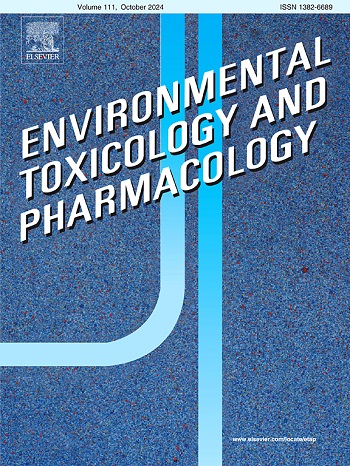Metalloplastic interaction triggers renal oxeiptosis: Novel insights into KEAP1/PGAM5/AIFM1 pathway in snakeheaded fish Channa punctatus
IF 4.2
3区 环境科学与生态学
Q2 ENVIRONMENTAL SCIENCES
引用次数: 0
Abstract
Oxeiptosis, discovered in 2018, is a ROS-triggered, caspase-independent cell death pathway studied so far only in mammals. Our study provides the first validation of oxeiptosis in an aquatic organism, expanding the understanding of oxidative stress-mediated cell death pathways in fish. Channa punctatus were exposed to environmentally relevant concentrations of Polyvinyl chloride microplastics (PVC-MPs) (0.5 mg/L) and copper (0.85 mg/L), both individually and in combination, for 60 days. Renal responses were evaluated through reactive oxygen species (ROS) accumulation, oxidative damage to lipids, proteins, and nucleic acids, alterations in creatinine levels, nephro-architectural deterioration, and oxeiptotic cell death. Notably, the highest copper accumulation was detected in kidneys exposed to copper-loaded PVC-MPs. Elevated ROS levels were accompanied by a decline in reduced glutathione (GSH), alongside oxidative damage markers such as heightened lipid peroxidation (LPO), protein carbonylation (PC), and 8-hydroxy-2′-deoxyguanosine (8-OHdG). Kidney dysfunction was evident from markedly increased creatinine levels, while pronounced renal architectural damage further reinforced the severity of toxicity. Molecular perturbations were more pronounced in kidneys exposed to the combined copper-PVC-MPs treatment. Transcriptional analyses indicated the upregulation of keap1, pgam5, and aifm1, with concurrent downregulation of nrf2, substantiating the occurrence of oxeiptosis. Additionally, Principal Component Analysis (PCA) and Pearson correlation analysis established strong associations between oxidative stress, molecular responses, and nephro-structural damage. These findings highlight that PVC-MPs act as carriers of heavy metals, amplifying oxidative stress and exacerbating renal dysfunction in aquatic organisms.
金属塑相互作用触发肾上凸:对马尾鱼KEAP1/PGAM5/AIFM1通路的新见解。
Oxeiptosis于2018年被发现,是一种ros触发的、不依赖caspase的细胞死亡途径,迄今为止只在哺乳动物中被研究过。我们的研究首次验证了水生生物的氧化凋亡,扩大了对鱼类氧化应激介导的细胞死亡途径的理解。将斑马鱼单独或联合暴露于与环境相关浓度的聚氯乙烯微塑料(0.5mg/L)和铜(0.85mg/L)中60天。肾脏反应通过活性氧(ROS)积累、对脂质、蛋白质和核酸的氧化损伤、肌酐水平的改变、肾结构恶化和氧化性细胞死亡来评估。值得注意的是,在暴露于含铜PVC-MPs的肾脏中检测到最高的铜积累。ROS水平升高伴随着还原性谷胱甘肽(GSH)的下降,以及氧化损伤标志物,如脂质过氧化(LPO)、蛋白质羰基化(PC)和8-羟基-2'-脱氧鸟苷(8-OHdG)升高。肌酐水平明显升高可表现为肾功能不全,而明显的肾结构损害进一步加强了毒性的严重程度。暴露于铜- pvc - mps联合处理的肾脏中,分子扰动更为明显。转录分析显示keap1、pgam5和aifm1上调,同时nrf2下调,证实了氧沉的发生。此外,主成分分析(PCA)和Pearson相关分析证实了氧化应激、分子反应和肾结构损伤之间的密切联系。这些发现强调PVC-MPs作为重金属的载体,在水生生物中放大氧化应激和加剧肾功能障碍。
本文章由计算机程序翻译,如有差异,请以英文原文为准。
求助全文
约1分钟内获得全文
求助全文
来源期刊
CiteScore
7.00
自引率
4.70%
发文量
185
审稿时长
34 days
期刊介绍:
Environmental Toxicology and Pharmacology publishes the results of studies concerning toxic and pharmacological effects of (human and veterinary) drugs and of environmental contaminants in animals and man.
Areas of special interest are: molecular mechanisms of toxicity, biotransformation and toxicokinetics (including toxicokinetic modelling), molecular, biochemical and physiological mechanisms explaining differences in sensitivity between species and individuals, the characterisation of pathophysiological models and mechanisms involved in the development of effects and the identification of biological markers that can be used to study exposure and effects in man and animals.
In addition to full length papers, short communications, full-length reviews and mini-reviews, Environmental Toxicology and Pharmacology will publish in depth assessments of special problem areas. The latter publications may exceed the length of a full length paper three to fourfold. A basic requirement is that the assessments are made under the auspices of international groups of leading experts in the fields concerned. The information examined may either consist of data that were already published, or of new data that were obtained within the framework of collaborative research programmes. Provision is also made for the acceptance of minireviews on (classes of) compounds, toxicities or mechanisms, debating recent advances in rapidly developing fields that fall within the scope of the journal.

 求助内容:
求助内容: 应助结果提醒方式:
应助结果提醒方式:


